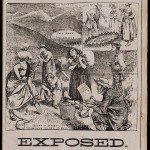First off, I readily admit that Mysteries of the Middle Ages, the title of a book by Thomas Cahill, is a bit hokey. It’s reminiscent of the worst kind of “documentary” on the History Channel or the Discovery Channel, or, even, of those billboards you still sometimes find along rural roads (“Astonishing Caves of Mystery! See Gravity-Defying Waterfalls! Marvel at the Three-Hundred-Year-Old Midget Lady!”), advertising ramshackle places where the laws of nature are suspended and you can witness it all for yourself for an admission price of just $5.95 for adults ($3.95 for children). I wonder who chose the title.
And apparently nobody could choose a subtitle, because the book has (count ’em!) not merely one, but two. On the cover, it’s called Mysteries of the Middle Ages and the Beginning of the Modern World, but, inside, in the publication data, it’s entitled Mysteries of the Middle Ages: The Rise of Feminism, Science, and Art from the Cults of Catholic Europe.
But no matter. It’s still a pretty good book, and a fascinating one. And neither subtitle quite conveys what the book does, anyhow.
The book isn’t so much a history of medieval Catholic Europe as it is a set of sketches of important (but somewhat arbitrarily chosen) personalities from a particular section of that history, the twelfth century through the early fourteenth century — essentially what is often called the “High Middle Ages.”
In succession, Cahill treats Hildegard of Bingen, Eleanor of Aquitaine (who, some will remember, once famously portrayed Katherine Hepburn in the classic film The Lion in Winter, opposite Henry II’s memorable depiction of Peter O’Toole), St. Francis of Assisi, the notorious but brilliant Peter Abelard, the even more brilliant and far more reputable St. Thomas Aquinas, the Oxford scientist Roger Bacon, the artist Giotto, and the incomparable Dante Alighieri.
Along the way, Cahill gets in occasionally quite aggressive digs at such folks as St. Bernard of Clairvaux (whose lovely hymn “Jesus, the Very Thought of Thee” fortunately or unfortunately fails to convey Bernard’s full character), as well as at George W. Bush, modern Catholic bishops, and, with the exception of John XXIII, all the popes since and including Pius XII. It’s a mark of Cahill’s style and approach, which can, on rare occasions, be blunt to to the point of obscenity, that he likes to take potshots at groups and people he disdains even when they have little or no connection to his actual subject. (In his earlier book How the Irish Saved Civilization, he tosses a gratuitous insult aimed at Mormonism into a discussion of the ancient faith known as Manichaeism, which had originated in Iran but had spread to the Latin West by the time of St. Augustine in the fourth century.)
I often disagree with Cahill’s political and religious opinions. But he’s a lively, learned, and consistently entertaining writer. And this book, in particular, is beautifully illustrated. If you’re interested at all in medieval Europe, you could do far worse than spending some hours with Mysteries of the Middle Ages. And, if you’re not interested in medieval Europe, Thomas Cahill might be able to change that.











